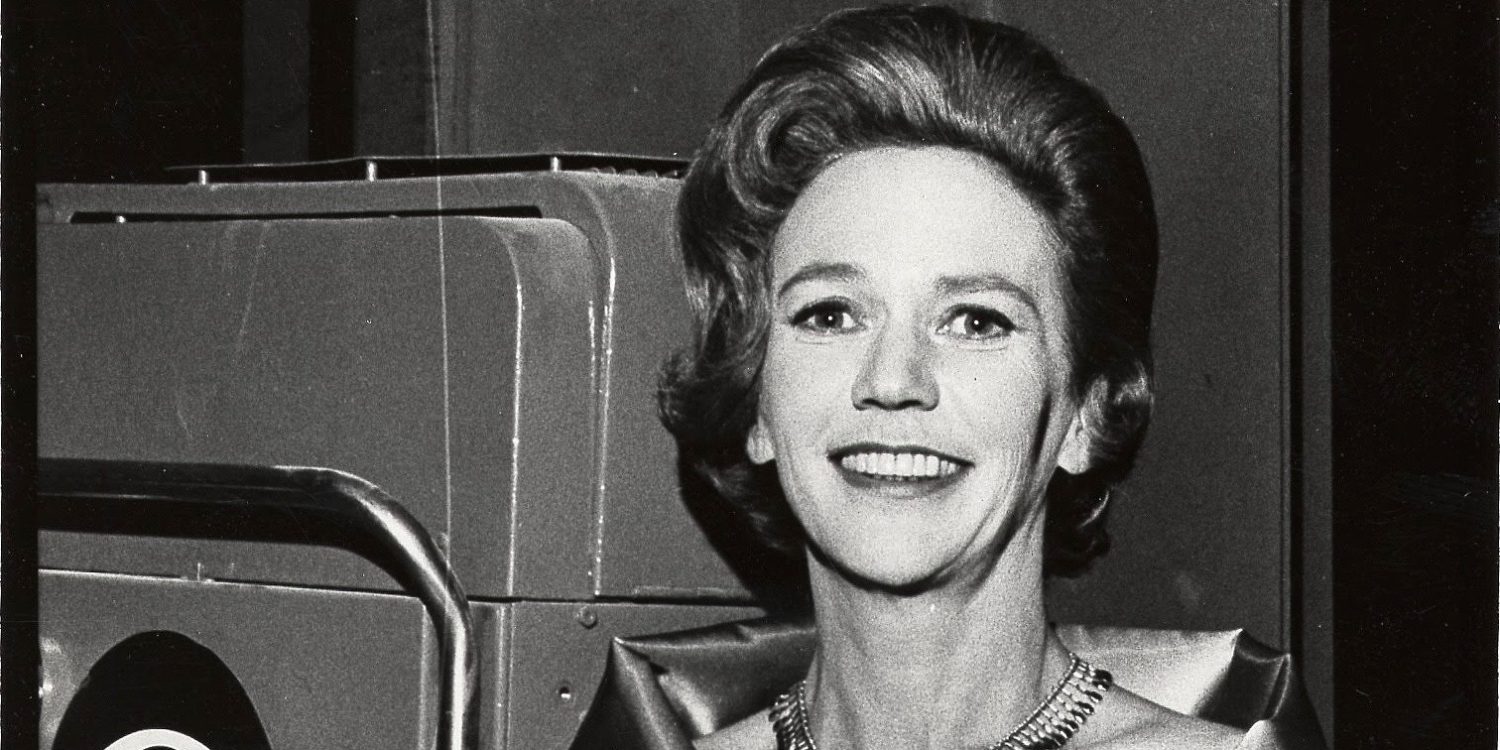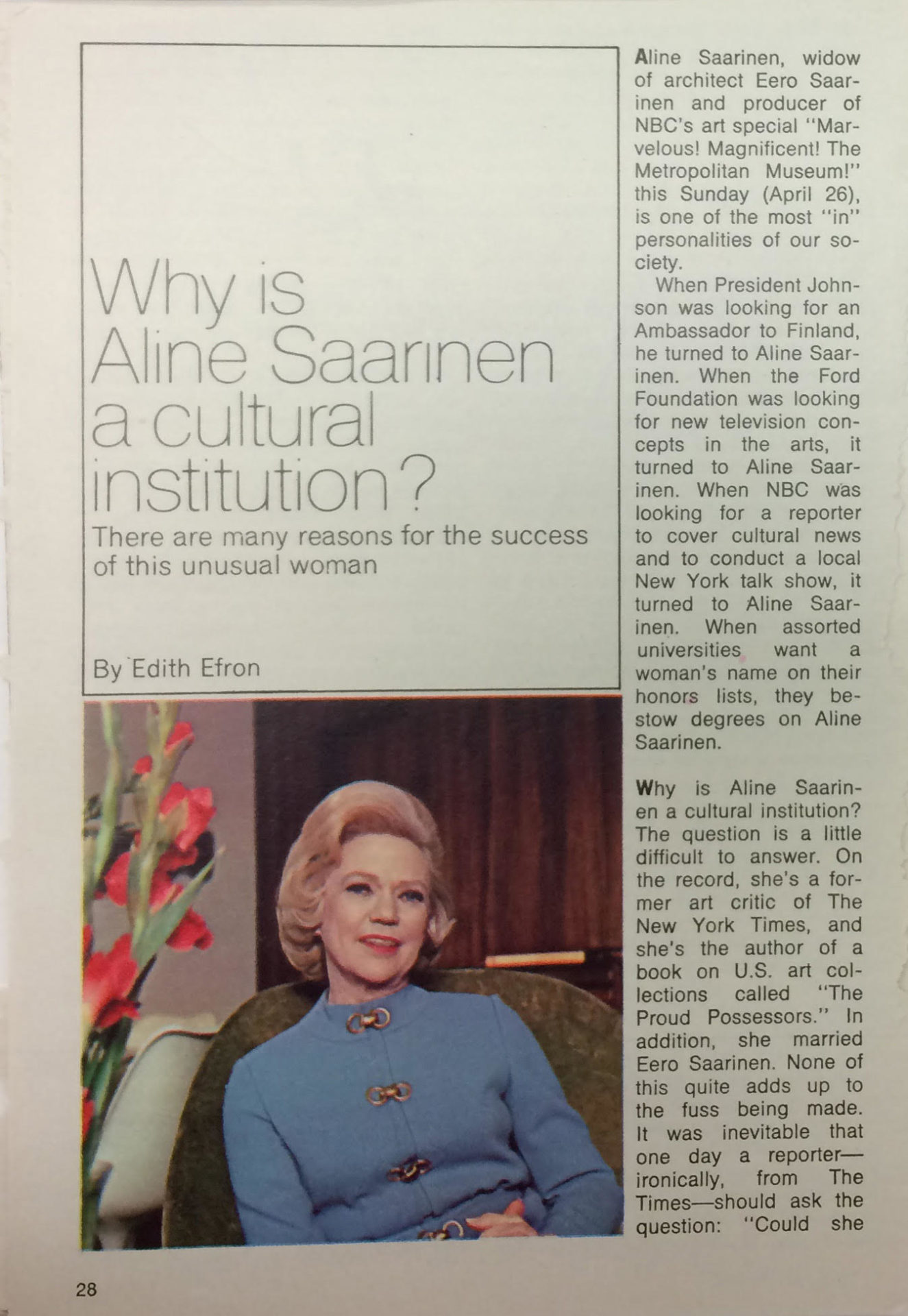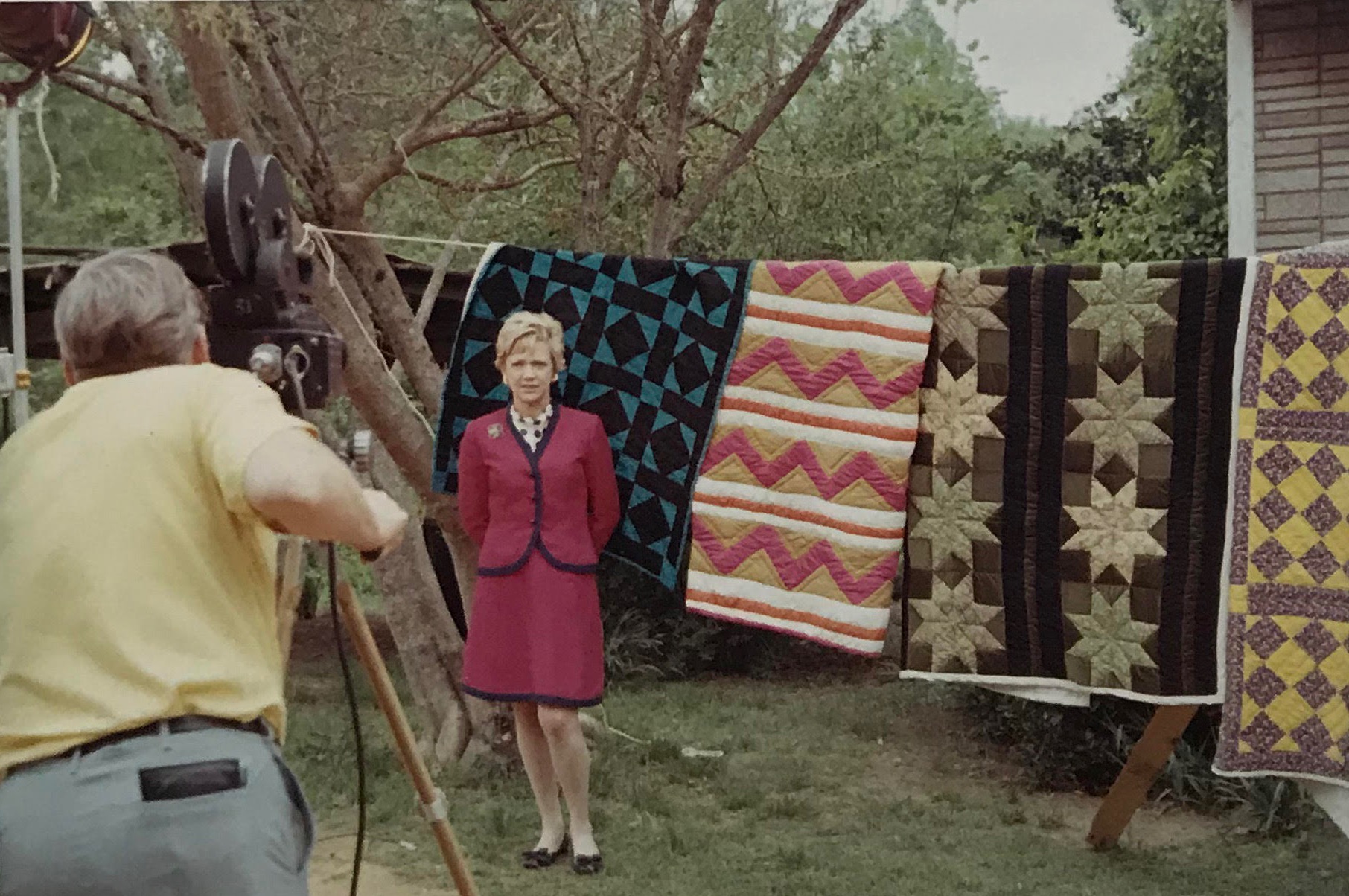Aline Saarinen might be the most influential American architecture critic you’ve never heard of. So well-known was Saarinen that her fame and status were taken for granted by TV Guide when it published an interview with her in 1970 titled “Why is Aline Saarinen a Cultural Institution?” She had already been the art critic for the New York Times and a best-selling author, when Saarinen began a career in television in 1962, after the death of her second husband, architect Eero Saarinen. She was the first art critic hired to make regular appearances on a network television program, namely NBC’s Today show, and was a frequent and popular presence on television throughout the 1960s. In her ten-year TV career, Saarinen reported in at least 150 broadcasts, including numerous segments on Today, as well as programs like The Frank McGee Report and Meet the Press. She was also featured in a number of prime-time specials, including The Art of Collecting (1964) and Bravo Picasso (1967), some of which she wrote and produced herself. Saarinen’s influence was arguably less due to what she said about architecture, her specific ideas and opinions, and more due to how she said it. With her style of criticism, Saarinen sent the message that everyone had a stake in good design, and moreover was something that anyone could engage with and have opinions about. With an audience much larger than most if not all of her peers, Saarinen played a key role in shaping the course of professional criticism, as well as the public conversation on architecture, in the postwar US.
Saarinen elevated discourse on architecture first by presenting it as a fine art, worthy of news coverage. She wrote articles on Louis Sullivan, Mies van der Rohe, and Gordon Bunschaft, but also on antiquities, Paul Cézanne, Pop Art, and medieval tapestries. On TV, she alternated segments on public housing in West Berlin, the architecture at Expo 67, and plans to renovate Frank Lloyd Wright’s Unity Temple with reporting on museum exhibitions, artists such as Andrew Wyeth and Isamu Noguchi, and events like the performances staged by the avant-garde group Experiments in Art and Technology (E.A.T.). In many ways, Saarinen’s approach to criticism represents the continuation in the post-World War II US of an ethos espoused by members of the prewar avant-garde. Figures like William Morris to Walter Gropius held that art should come out of the rarefied world of the museum and into the daily lives of ordinary people. Like her prewar predecessors, Saarinen felt strongly that knowledge of and appreciation for art as something that should be accessible to everyone and used the mass media as a means of realising this goal. Her effort to reach the broadest possible audience-led Saarinen to publish in magazines like Vogue and McCall’s and, ultimately, to television. “We’re on a culture kick,” she told the Associated Press in 1963, “but I do think American taste is improving . . . I hope I can help. That’s what I’m on television for.”
Television proved an ideal venue for Saarinen’s criticism, well-suited to her open, frank style of presentation. As she described it in a 1963 NBC press release, “There’s Mama fixing breakfast and Papa shaving and I try to give them something about art—without preaching.” Critics often remarked on her ability to serve as an authority on her subject without coming across as condescending. In 1969, John Canaday wrote in the New York Times that Saarinen proved “it is possible to talk to a mass audience about art without resorting to the sentimental treacle that usually passes for interpretation or the gibberish that passes for erudite comment.” While accessible and engaging, Saarinen was also unafraid to voice polarising opinions, a trait which undoubtedly added to her appeal. She gained particular notoriety when she listed the six ugliest man-made objects in America for the Today show, including the Pan Am Building in New York and what she called “the typical builder’s home.” At the top of her list was Mount Rushmore, which she deemed “first candidate for the garbage can.”
Saarinen’s approach to television production was also a big part of what made her programs popular. She avoided producing television that was self-consciously educational, remarking in a 1969 interview with the New York Times, “TV should move you, get you off balance . . . if we can scatter art spots into the evening news or ‘The Frank McGee Report,’ I think it’s a better way to use the medium.” As she became more involved in producing her specials and news segments, Saarinen employed techniques borrowed from TV commercials and Laugh-In. She embraced the use of colour, music, and techniques like jump cuts and montage to produce programming that she stressed was “entertainment—not education.”
Judging from the cards and letters sent to her by viewers, Saarinen’s efforts seem to have attracted a sizeable and appreciative audience. Elizabeth H. Marshman of Lake Worth, Florida wrote NBC about one of Saarinen’s specials in 1970, saying “Just want you to know how much we appreciate the really good, cultural [sic] programs you present.” In 1964, Mrs Alcine Maher of Ansonia, Connecticut wrote “You are one of my favourite people. I enjoy hearing you on the Today Show and am always delighted when you are on.” While Saarinen was often introduced as “Mrs Eero Saarinen” earlier in her career, she soon became famous on her own terms. Of the newspaper clipping she had enclosed with her letter, Mrs Maher wrote, “Saw this in the New Haven Register . . . and in looking over the various Yale buildings by famous architects [I] find one by Eero Saarinen. Was he your husband?” Saarinen’s impact went beyond her popularity with TV viewers. It was in large part due to Saarinen that the New York Times hired Ada Louise Huxtable to write architectural criticism for the paper. As Huxtable later recalled, “when she married Eero Saarinen, she thought she should not write about architecture anymore. The Times’s editors were upset; they said they needed to get someone else, and so she recommended me.” Writing for the New York Review of Books in 1967, architecture critic Reyner Banham declared that Saarinen had, along with MoMA and others, created “a new architectural public.”
While undoubtedly successful, Saarinen’s career also exemplifies many of the tensions around popular architectural criticism and of television as a venue for it. For example, by embracing the spectacular aspects of television in her arts specials, Saarinen was engaging directly with a central contradiction of news production in this era. Established in the US as a for-profit business, television relied on ratings and advertising dollars for its revenue, however, was at the same time expected by government and cultural leaders to serve in the public’s interest. In the wake of a quiz show scandal that led to a US Senate investigation, networks were under acute pressure in the 1960s to prove that they could produce something more substantial than entertainment-oriented programming. News broadcasts were a critical way networks demonstrated their commitment to the public, but these, too, had to be profitable. To capture viewers’ attention, many television news bureaus turned to arts programming.
Arts coverage was inherently visual, and it held greater popular appeal compared with coverage of poverty, racial tensions, or the Cold War. However, there was also a contradiction inherent in popularising high culture. In the postwar US, the culture of fine arts and architecture was defined in terms famously laid out by Clement Greenberg in his 1939 essay “Avant-Garde and Kitsch”: in opposition, that is, to mass-produced, consumer-oriented kitsch. By this definition, once everyone owned a fine art object, it was no longer a fine art object. This attitude is evident in, for example, Banham’s wincing account of the architectural public he argued Saarinen and others had helped create, a public which he charged, “flatters itself by believing it understands something of the professional mysteries of architecture.” It also has to be said that the messages of TV arts programming were heard by and, to a certain degree, intended for a relatively circumscribed audience. Producers of such programs gave relatively scant attention, for example, to the concerns and artistic practices of African-Americans. And even on TV, arts programming often required or assumed pre-existing knowledge on the part of its audience.
Saarinen’s career as a critic and journalist represents both the exception and the rule with regard to popular architectural criticism. With her skilful use of the television medium, combined with her intelligence, enthusiasm and sharp commentary, Saarinen was particularly adept at resolving tensions between social responsibility and economic profitability. Saarinen also modelled what might be called a democratic approach to criticism, one that managed to be discerning and knowledgeable without seeming elitist or exclusionary. She made it clear that, simply because a particular work was by a famous architect or endorsed by an esteemed institution, did not make it automatically worthy of her praise. She was moreover not overly beholden to any particular style or artist, nor did she generally expect others to adopt her opinions. With segments that, for example, instructed viewers on how to visit museums (don’t try to see every artwork) or spot a fake (don’t be fooled by “ridiculous bargains”), she clearly hoped to instil within Americans the idea that they should and could participate actively in the arts. While in many ways Saarinen represented and often endorsed a particular east-coast and Eurocentric vision of high culture, she also covered topics that were ignored by many others, such as folk art, environmental design, poster art, and “Afro-American” art.
With the establishment in 1969 of the Public Broadcasting Service in the US, arts programming was increasingly confined to PBS stations, and network news bureaus focused more exclusively on hard news. Not only were there far fewer hybrid news-arts programs of the kind Saarinen had pioneered, arts programming produced for PBS generally took the kind of self-consciously educational approach Saarinen railed against.
The expansion of media formats over the past twenty years has in some ways reversed this trend, allowing for a more visually- and entertainment-oriented engagement with topics related to art and design. The idea, endorsed by Saarinen, that design is part of everyday life is also now commonly held. At the same time, however, TED talks and online publications like ArchDaily or Dezeen present architecture and design largely in terms of their formal aesthetics. Missing are both the social and political dimensions of architecture, as well as the more historically-grounded approach preferred by Saarinen. The result is a narrow discourse, preoccupied on the one hand with style, as communicated through pristine pictures of high-end homes or sleek product design, and on the other, by critiques made for and by people who are already insiders. What is missing is writing that encompasses architecture in all its dimensions, including social, political, and economic, and that encourages a broad spectrum of readers to join in its critique.
Saarinen’s engagement with design, by contrast, was centred on the act of critique, and moreover, she was clearly committed to the notion of teaching people how to be critics, rather than telling them what artworks or styles they should like. In a 1966 interview with Home Furnishings Daily, for example, Saarinen insisted that there were no objectively right or wrong ideas about art or architecture, stating, “Good taste is a ridiculous phrase—whose good taste? The decorator’s? Taste changes: what was considered ugly in one era is considered beautiful in another.”
In her life and work, Saarinen deftly navigated many apparent contradictions. She was outspoken and opinionated yet engaging; she embraced the high-brow and was at the same time incredibly eclectic in her tastes. She brought insightful and educated analysis of buildings and design to a popular medium and moreover invited everyone to take part in this discourse with her, ultimately raising the level of architectural discourse in the US. Saarinen certainly was, as TV Guide concluded, “an interesting and unusual human being,” but also one whose approach provides a model for arts and architectural criticism that remains relevant today.



